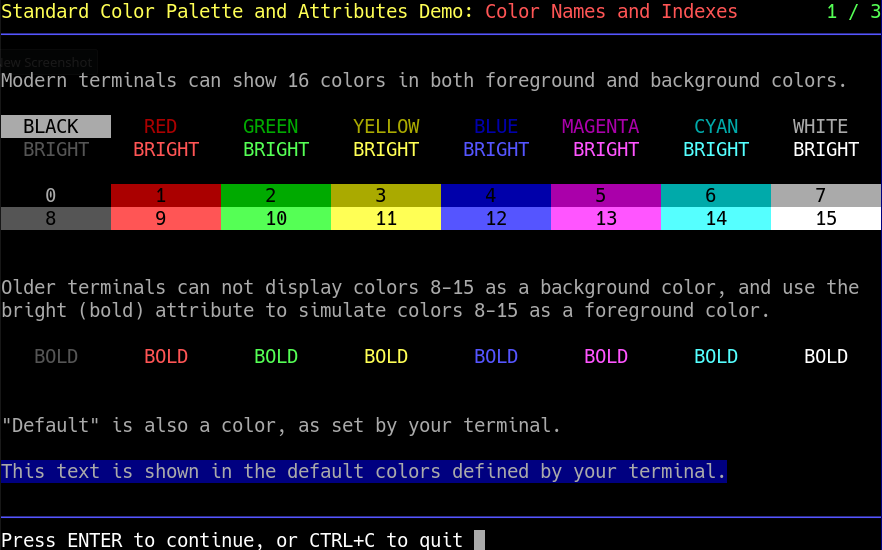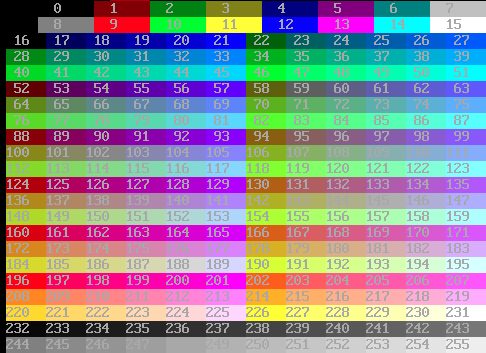Glitch Terminal
We also offer a Full ANSI implementation terminal, originally based upon the fTelnet project on github from Rick Parrish. While fTelnet itself is an amazing product, it was not complete. At the time that I forked the code fTelnet did not understand all of the standard ANSI color codes, also it did not support all of the game fonts and sounds we wanted to incorporate.

ANSI Sequences
CSI is a standard term used in terminal specifications, it means:
| ESC [ | 0x1B0x9B | Control Sequence Introducer |
Pn is how we represent a numeric parameter in the following specifications.
Pt is how we represent a text parameter in the following specifications.
Ps is how we represent a space character in the parameters in the following specifications.
Pc is how we represent an individual character parameter in the follow specifications.
Uppercase Command Letter
| CSI Pn A | Move the cursor UP. Defaults to 1 If the cursor is at the top of the display the command is ignored. If the Pn would move the cursor above the top of the display, the cursor stops on the top line. This is sent from a terminal to the BBS when the UP arrow is pressed. This is also sent from the terminal with mouse wheel scroll up. |
|---|---|
| CSI Pn B | Move the cursor DOWN. Defaults to 1 If the cursor is at the bottom of the display the command is ignored. If the Pn would move the cursor below the last line of the display, the cursor stops on the bottom line. This is sent from a terminal to the BBS when the DOWN arrow is pressed. This is also sent from the terminal with mouse wheel scroll down. |
| CSI Pn C | Move the cursor RIGHT Defaults to 1 If the cursor is at the right margin of the display the command is ignored. If the Pn would move the cursor beyond the right margin, the cursor stops on the last character for this line. This is sent from a terminal to the BBS when the RIGHT arrow is pressed. |
| CSI Pn D | Move the cursor LEFT |
| CSI Pn ; Pn Ps D | Change Display Font |
| CSI Pn E | Move the cursor DOWN and HOME |
| CSI Pn F | Move the cursor UP and HOME This is sent from a terminal to the BBS when the END key is pressed. |
| CSI Pn G | Move the cursor to X |
| CSI Pn ; Pn H | Move the cursor to X/Y This is sent from a terminal to the BBS when the HOME key is pressed. |
| CSI Pn I | Cursor Forward Tabulation |
| CSI Pn J | Clear the Screen |
| CSI Pn K | Clear the current Line |
| CSI Pn L | Insert Line(s) |
| CSI Pn M | Delete Line(s) or ANSI Music |
| CSI Pn N | Different ANSI Music |
| CSI Pn O | ? |
| CSI Pn P | Delete Character(s) |
| CSI Pn ; Pn ; Pn Q | In RIP Mode, change Font |
| CSI Pn R | ? |
| CSI Pn S | Scroll Screen UP |
| CSI Pn T | Scroll Screen DOWN |
| CSI Pn U | Clear Screen with Default Attribute |
| CSI Pn V | ? |
| CSI Pn W | I use the unused W command for my WRO Protocol |
| CSI Pn X | Replace the next Pn characters with Space Gray on Black |
| CSI Pn Y | Emoji Sequence |
| CSI Pn Z | Cursor Backward Tabulation |
Lowercase Command Letter
| CSI Pn a | ? |
|---|---|
| CSI Pn b | Repeat last character Pn times |
| CSI Pn c | Terminal Query |
| CSI Pn d | ? |
| CSI Pn e | ? |
| CSI Pn ; Pn f | Goto X/Y Like CSI Pn H |
| CSI Pn g | Tabulation Clear. Default is 0 If Pn is 0 forget current tab position. If Pn is 3 then forget all tab positions. |
| CSI Pn h | Set Mode If Pn is 4 then Insert On |
| CSI ? Pn h | Restore Terminal Mode(s) |
| CSI Pn i | ? |
| CSI Pn j | ? |
| CSI Pn k | ? |
| CSI Pn l | Set Terminal Mode(s) |
| CSI Pn m | Set Video Mode(s) |
| CSI Pn n | Device Status Report |
| CSI Pn o | ? |
| CSI Pn p | ? |
| CSI Pn q | ? |
| CSI Pn ; Pn r | Set Scroll Region. The first Pn is TOP line and next Pn is BOTTOM line. |
| CSI Pn s | Save Current Cursor X/Y Position |
| CSI Pn ; Pn ; Pn ; Pn t | Terminal Settings If 1st Pn is 0 then set 24bit Background Color. If 1st Pn is 1 then set 24bit Foreground Color. If 1st Pn is 8 then resize Window in Rows ; Columns. |
| CSI Pn u | Move cursor to Saved X/Y Position See CSI Pn s |
| CSI Pn v | ? |
| CSI Pn w | ? |
| CSI Pn x | ? |
| CSI Pn y | ? |
| CSI Pn z | ? |
Character Command Letter
| CSI Pn @ | Insert Pn Characters, Defaults to 1 All characters to the right of the cursor are pushed to the right. The character at the right margin is destroyed, it does not push to the next line. This is sent from a terminal to the BBS when the INS key is pressed. |
|---|---|
| CSI Pn ; Pn ^ | Modify Text Cursor Size and Color. If the first parameter is 0 (zero) you are setting color. The cursor code expects ANSI-256 color code. If the first parameter is 1 you are setting size. 0=None, 1 to 100 are supported. 100=BLOCK. |
| CSI Pn *r | Force an Emulated Baud Rate. 0=unlimited, 1=300, 2=600, 3=1200, 4=2400, 5=4800, 6=9600, 7=19200, 8=38400, 9=57600, 10=76800, 11=115200 |
| CSI Pn ` | Move cursor to column on current row, Defaults to 1 Same as CSI Pn G |
Common Sequences
ANSI Detection
When a BBS checks to see if a terminal supports ANSI, it is common to send from the BBS to the terminal one of the following sequences.
| CSI 6 n | Where is your terminal cursor currently? This is a very basic way to say “Hey! Do you support ANSI?” The terminal will respond with CSI ROW ; COL R |
|---|---|
| CSI 255 B CSI 255 C CSI 6 n | Tells the terminal to move the cursor 255 rows down (which stops at the bottom of the screen). Tells the terminal to move the cursor 255 columns to the right (which stops at the right margin of the screen). Then ask where is your terminal cursor currently? This will reply back CSI 80 ; 25 R for an 80×25 DOS Terminal. |
Unicode Detection
Since we can get a reply “Where is the cursor?” when testing for ANSI support. I realized why not send Clear Screen, followed by 3 Unicode Characters, followed by CSI 6 n. Once I proved this worked with 4 different terminals that support Unicode, and the reverse logic works for all terminals that do not understand Unicode, I shared my logic with other BBS authors.
| CSI 2 J 3 Unicode CSI 6 n | The Unicode Characters used are 3 characters each (9 characters total) A terminal will return either CSI 1 ; 4 R if it understood, or CSI 1 ; 10 R or CSI 1 ; 13 R if it did not understand. Not rocket science ~ however, something everyone overlooked for the past two (2) decades. |
|---|
Mouse Sequences
Okay, out of the main terminals for connecting to your BBS ~ mouse tracking seems to be implemented differently (if at all). NetRunner and xTerm both seem to support sending mouse clients when they receive CSI ? 1000 h. SyncTerm requires a proceeding CSI = 255 h (DOORWAY mode on), however, it does not send CLICK on 0x00 } as you drag your mouse.
xTerm Specification
| CSI M Ps Pc Pc | Mouse Down Event Pc is 32+X or Y. So 1+32 = !. So 1,1 is sent as !! Mouse sequences are sent in X/Y not your standard Row/Col like other ANSI commands. |
|---|---|
| CSI M # Pc Pc | Mouse Up Event Pc is 32+X or Y. So 1+32 = !. So 1,1 is sent as !! Mouse sequences are sent in X/Y not your standard Row/Col like other ANSI commands. |
NOTE A Single click will return both sequences CSI M !! and CSI M#!!. If you drag your mouse to a different position, then the CSI M# will contain a different X or Y character.
NetRunner Specification
| CSI M 0 Pc Pc | Mouse Click Event Pc is 40+X or Y. So 1+40 = ). So 1,1 is sent as 0)) Mouse sequences are sent in X/Y not your standard Row/Col like other ANSI commands. |
|---|
NOTE NetRunner sends only the starting click ~ so no support for drag.
Glitch Extensions
To improve UX (User Experience), after researching every specification I could find, I ended up having to add Legacy/X BBS ANSI extensions:
| CSI Pn O | Where Pn is the ASCII number of the character you wish to flood fill the background with. The command is the letter O (not zero). Example: CSI[176O produces your standard #176 background like RASETUP. |
|---|
Of course, this lends itself to be useful for desktop applications with popup windows, and dropdown menus. So, to improve the performance of showing something then returning back to the text or image behind it. I added the V command sequence for save to Video Buffer, and the R command sequence for restore from Video Buffer.
| CSI Pn1;Pn2;Pn3;Pn4 V | Pn1 is the starting left column. Pn2 is the starting top row. Pn3 is the ending column, Pn4 is the ending row. Example: CSI[1;1;80;5V stores the top 5 rows to the video buffer. |
|---|---|
| CSI Pn1;Pn2;Pn3;Pn4 R | Pn1 is the starting left column. Pn2 is the starting top row. Pn3 is the ending column, Pn4 is the ending row. Example: CSI[1;1;80;5R restores the top 5 rows from the video buffer. |
Of course, this also means you can copy a region to the video buffer, then stamp it at different positions on the screen, to emulate animation (character movement for example).



